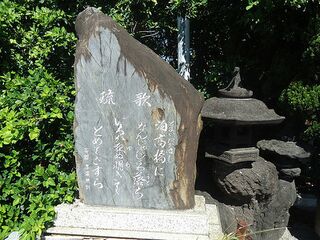Difference between revisions of "Ryuka"
From SamuraiWiki
Jump to navigationJump to searchm (adding example) |
|||
| (One intermediate revision by the same user not shown) | |||
| Line 1: | Line 1: | ||
| + | [[File:Tomaribashi-ryuka.jpg|right|thumb|320px|A stone inscribed with a ''ryûka'' about [[Tomari]] Takahashi (Tomari High Bridge)]] | ||
*''Japanese'': 琉歌 ''(ryuuka)'' | *''Japanese'': 琉歌 ''(ryuuka)'' | ||
| Line 5: | Line 6: | ||
Songs in the classical Okinawan repertoire of ''uta-sanshin'' (song accompanied on ''[[sanshin]]'') are often based on ''ryûka''. | Songs in the classical Okinawan repertoire of ''uta-sanshin'' (song accompanied on ''[[sanshin]]'') are often based on ''ryûka''. | ||
| − | A famous example, which appears in the ''[[Omoro soshi|Omoro sôshi]]'', and which serves as the lyrics for the classical song ''Kajadifu bushi'': | + | A famous example, which appears in the ''[[Omoro soshi|Omoro sôshi]]'', and which serves as the lyrics for the classical song ''[[Kajadifu-bushi]]'': |
{| | {| | ||
Latest revision as of 23:19, 11 May 2018

A stone inscribed with a ryûka about Tomari Takahashi (Tomari High Bridge)
- Japanese: 琉歌 (ryuuka)
Ryûka is the most standard form of traditional poetry in the Ryûkyû Islands. A standard ryûka consists of four lines, with an 8-8-8-6 mora structure (in contrast to the 5-7-5-7-7 structure of Japanese tanka).
Songs in the classical Okinawan repertoire of uta-sanshin (song accompanied on sanshin) are often based on ryûka.
A famous example, which appears in the Omoro sôshi, and which serves as the lyrics for the classical song Kajadifu-bushi:
| きゆぬふくらしゃや | Kiyu nu fukurasha ya |
| なうにじゃなたてぃる | Nau ni jana tatiru |
| つぃぶてぃをるはなぬ | Tsibudioru hana nu |
| つぃゆちゃたぐとぅ | Tsiyu chata gutu |
References
- Thompson, Robin. "The Music of Ryukyu." Ashgate Research Companion to Japanese Music. Surrey: Ashgate Publishing, 2008. p311.